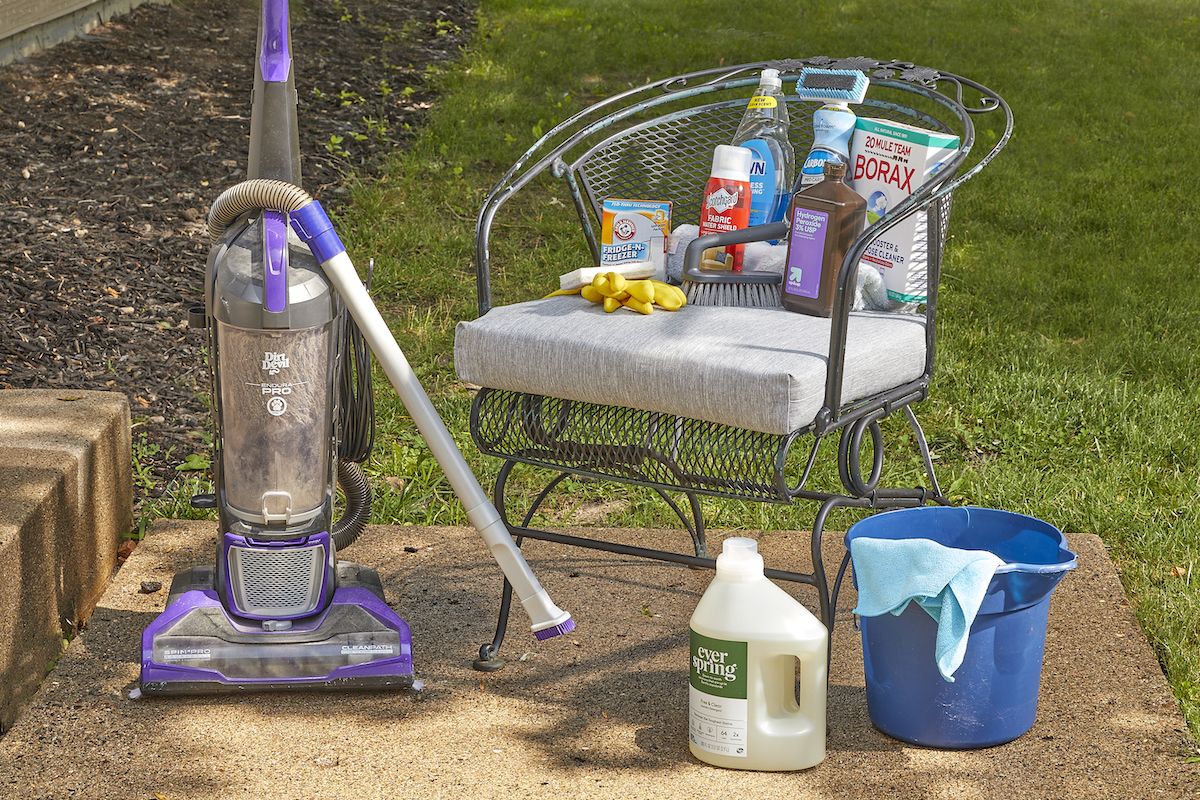We may earn revenue from the products available on this page and participate in affiliate programs. Learn More ›
Because they remain outdoors for a good portion of the year, patio cushions weather plenty of dirt and debris. Bird droppings, pollen, tree sap, and blown dirt and lawn debris can make them grimy. Exposure to rain and snow, too, can cause them to mildew. These cushions also get plenty of abuse in warmer months, when family members and guests enjoy food and beverages on the patio or near the pool. Cleaning outdoor furniture should rank high on your yearly to-do list, particularly if patio chair cushions have been out in the elements all winter long.
Fortunately, many patio cushions are designed with removable covers that slip off for throwing into a washing machine on the gentle cycle. Even if your patio cushions don’t have removable covers, you still can get them clean in preparation for outdoor fun: Just follow these simple steps for how to clean patio cushions.
Tools & Materials
Bobvila.com may earn a commission from purchases made through these links.
- Vacuum
- Upholstery attachment
- Bucket
- Sponge
- Soft scrub brush
- Garden hose
- Spray bottle
- Microfiber cloth
- Dishwashing liquid
- Borax
- All-purpose stain remover
- Towels
- Fabric protector spray
- Enzyme-based stain remover
- Liquid laundry detergent
- Baking soda or cornstarch
- Hydrogen peroxide
Project Overview
Working Time: 20 to 30 minutes
Total Time: 3 to 5 hours
Skill Level: Beginner
Estimated Cost: $10 to $20
Before You Begin

Gather your cleaning tools and supplies and remove cushions from their storage location or from the patio furniture frames. Choose a spot outdoors where you can easily plug in and use your vacuum, and you can lay the cushions while washing to avoid getting them dirty in the process. Wet dirt and loose grass blades can splash up if you wash cushions in the yard, so choose a hardscape area or lay a tarp down on grass to help keep cushions clean. Also be aware that borax, bleach, and some dish soap—at least in concentrated amounts—can kill grass or plants.
How to Clean Patio Cushions
There are a few ways to clean outdoor cushions, and the best method for you to use will depend on the construction, fabric, and care instructions of your own furniture. Cleaning outdoor cushions at least once or twice a year will keep them looking their best and prolong the lifespan of your patio furniture. Before putting away your patio furniture for fall and winter, or when getting it out of storage for spring and summer use, take the opportunity to clean and repair any dirty or damaged patio cushions.
Cleaning your cushions is a fairly simple project that doesn’t require a lot of specialized tools or cleaning products. Here’s how to get the job done.
Step 1: Vacuum the patio cushions.
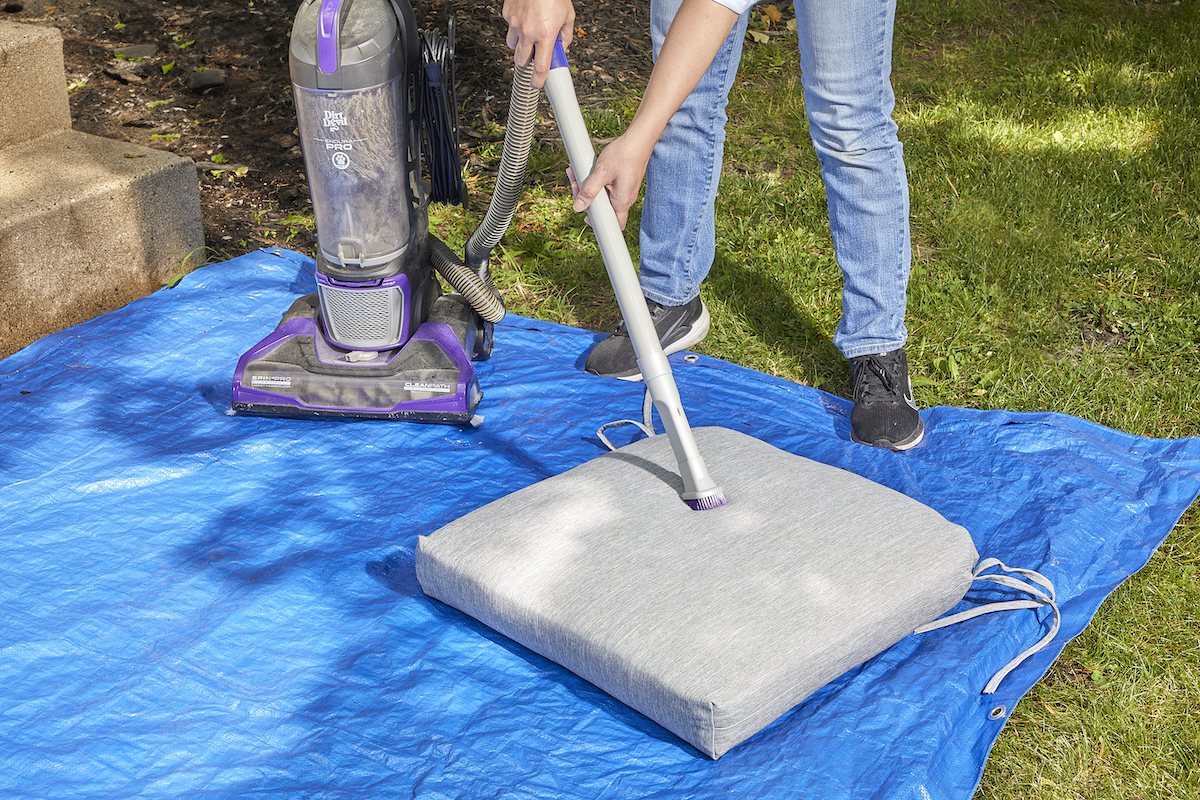
First remove any loose dirt and dust using your vacuum cleaner’s upholstery attachment. If your patio cushions are tufted, be sure to run an attachment carefully over the buttons, crevices, and seams.
Step 2: Remove cushion cases.
If your patio cushion covers are removable, unzip them and set the cushion inserts in a clean, dry location. Check the manufacturer’s care label: If it says a patio cushion cover is machine washable, you can avoid hand-washing outdoor cushions. Unzip these cushion and pillow cases and run them through the washing machine. Be sure to check the products’ care labels for temperature or cycle recommendations, and drying instructions.
Step 3: Wash the cushions with a cleaning solution.

For those patio cushions that can’t go in the washer, mix 1 tablespoon of dishwashing liquid in a bucket of warm water. If your cushions are mildewy, add ¼ cup of borax to the solution. Soak removable patio cushion covers in the solution for about 15 minutes, then check them for cleanliness or stains.
If cushions have a permanent cover, set them on a clean surface like a patio or cover the grass with a tarp to keep the cushions clean. Then generously sponge the sudsy solution onto the cushions. Let them soak for 15 minutes.
If you still see stubborn, dirty spots after soaking the cushions or covers, apply the cleaning solution again using a soft scrub brush. If that fails, try an all-purpose stain remover like Carbona Pro Care Outdoor Cleaner and refer to the steps below for removing specific stains.
Step 4: Rinse the cushions with a garden hose.

Thoroughly hose off the patio cushions or covers. Don’t use a pressure washer for the task, since it might damage the fabric. (On the other hand, if your patio furniture frames need cleaning, you can use a pressure washer on its lowest setting.)
Step 5: Dry the patio cushions completely.
If a machine washable cover is also dryer-safe, follow the label instructions for drying. Hang other removable patio cushion covers on a clothesline or other clean spot to air-dry. After washing a complete cushion and cover, squeeze out excess water, wrap a towel around the cushion to blot up most of the remaining water, and then stand the cushion up on its end to air-dry completely.
Choose a clean and sunny spot for drying the cushions. Hanging them on a clothesline might work and can give them the best combination of sun and airflow. Or you can prop the cushions up against a sunny wall. To fully dry, flip them after a few hours to give the other side some air and sun exposure. Drying time will vary based on weather and cushion materials.
Avoid applying heat, but set the cushions under or near an outdoor fan if they are taking too long to dry. Make sure no moisture remains by squeezing or sitting on them carefully and leave them to dry further if moisture remains. This will lessen the chance of mildew growth.
Step 6: Spray cushions with a fabric protector.
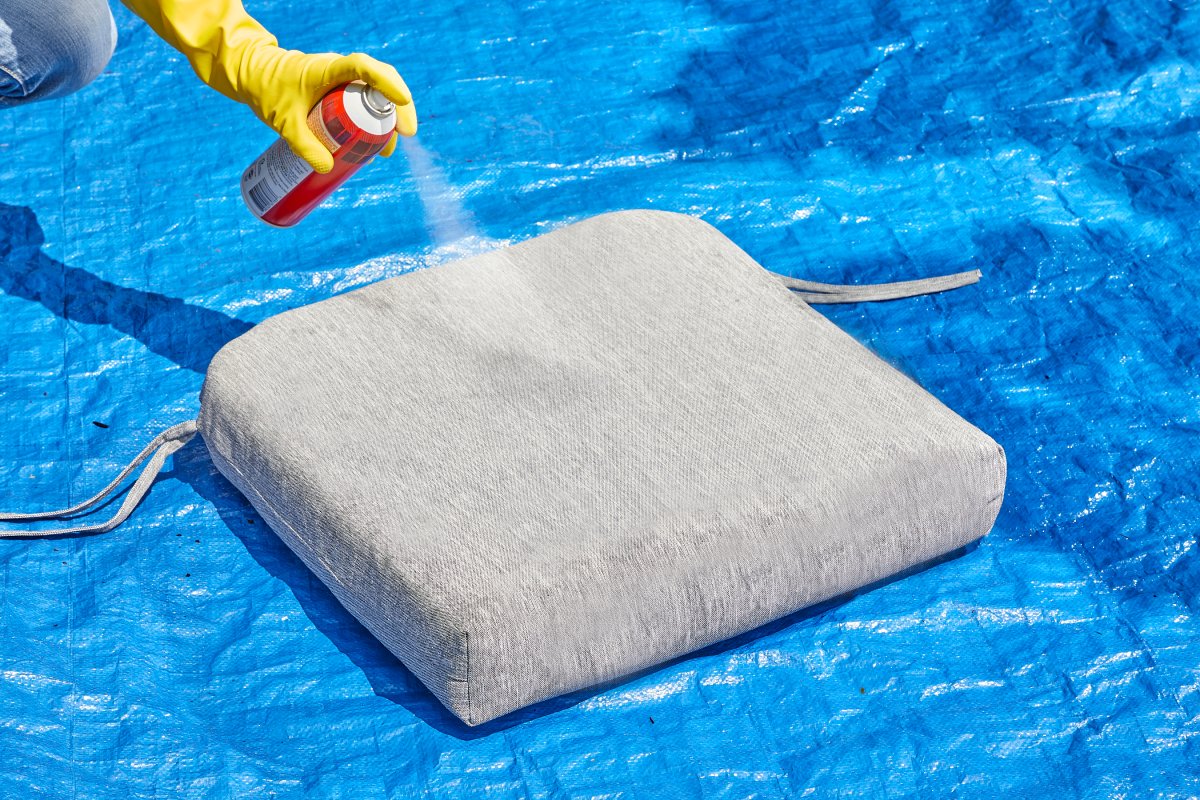
Once your cushions are dry, spray them with a fabric protector such as Scotchgard Water & Sun Shield to help them resist dirt and stains from things like fruit punch, dripping popsicles, and sunscreen. Taking this step now will make it much easier to keep those cushions clean the rest of the year.
How to Remove Stains From Outdoor Furniture Cushions
Makers of most outdoor furniture cushions use fabrics and materials that are specially designed to resist moisture, fading, and stains. Common outdoor cushion fabrics include woven acrylics, which are extremely durable, quick-drying, and resistant to mold and mildew. Olefin fabrics are manmade fibers created from melting plastic pellets, and also are durable and fade-resistant. Polyester fabrics typically are treated with stain-resistant sprays; however these fabrics can fade over time.
Despite their typically robust construction, all types of outdoor fabrics are susceptible to stains. Each type of stubborn stain requires a slightly different approach and specific cleaning products other than an all-purpose stain remover. Try some of these suggestions to remove marks from patio cushions or pillows.
Mold and Mildew
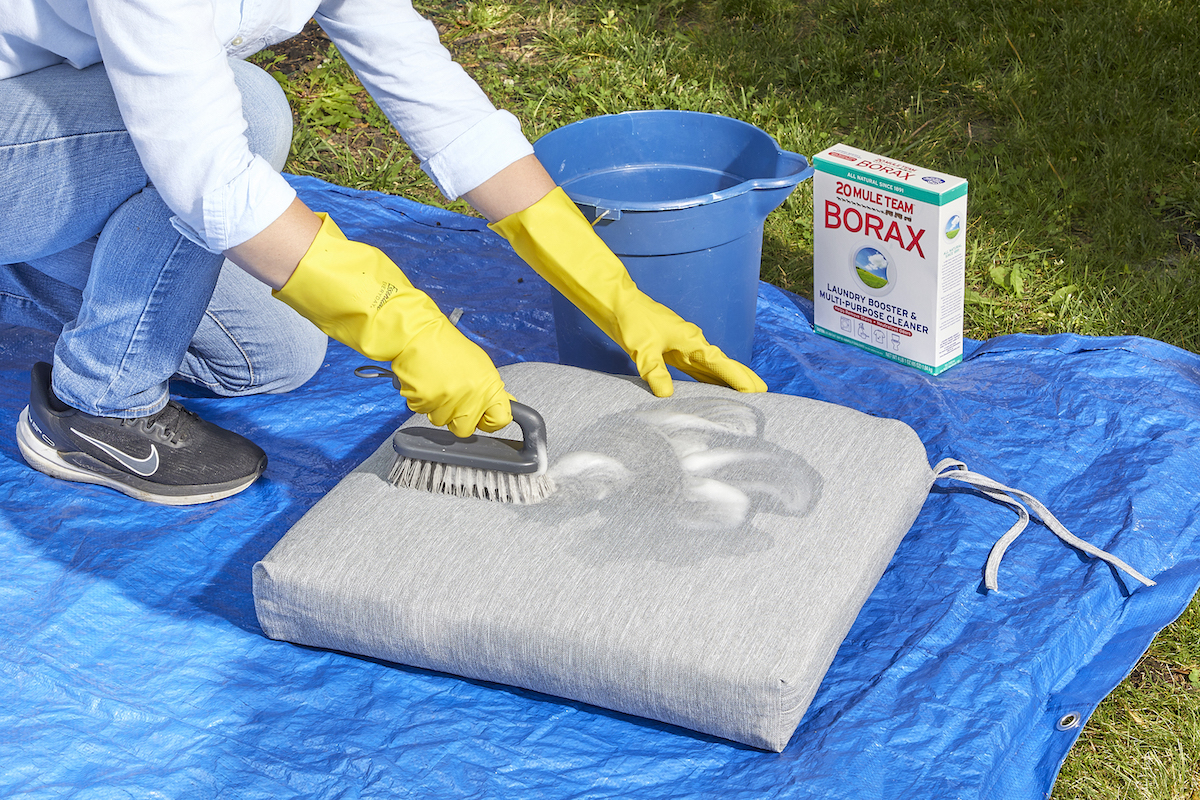
Mold and mildew are likely anytime damp, humid conditions combine with dirt, which pretty much describes the environment for outdoor furniture in many areas. Mold and mildew cause unsightly stains and blemishes on fabrics, and can exacerbate allergies, asthma, and other health issues.
Here is how to clean mildewed patio cushions:
- Mix 1 cup of borax with 4 cups of water to make a cleaning solution.
- Apply the mixture liberally to the fabric with a brush or sponge and blot with a clean microfiber cloth. (For stubborn stains, allow the cleaning solution to soak for up to 30 minutes.)
- Rinse the cushions thoroughly, stand them on their ends, and allow them to air-dry.
Another homemade cleaning solution that is suitable for some fabrics to rid them of mildew is 1 tablespoon of bleach mixed with 1 pint of water; follow the same instructions, but be sure to first test the mix in an inconspicuous area to make sure the bleach doesn’t discolor the fabric.
Before testing the bleach mixture, see if the cushion’s care label warns against use of bleach. Generally, bleach is not safe for some dyes and fabrics such as spandex, wool, and leather. Most outdoor fabrics are probably OK to bleach unless their washing instructions clearly state that they should not be exposed to chlorine. Olefin and Sunbrella fabrics, for example, carry color throughout their fibers instead of just on the surface, and should resist bleach damage.
Tree Sap
Tree sap is a really tough stain to remove because it is both sticky and oily. For this reason, getting rid of tree sap stains on outdoor cushions is a multistep process.
- Apply an enzyme-based stain remover directly to the stain and allow it to soak for 15 minutes.
- While it is soaking, make a paste using powdered laundry detergent and water.
- Apply the paste to the stain with a soft-bristle brush, rubbing gently side to side with the weave of the fabric.
- Rinse the fabric with hot water; repeat if necessary.
Bird Droppings
Our feathered friends have the habit of “going” wherever they perch, leaving behind a mess. To clean bird droppings from outdoor furniture, first let it dry and use a clean microfiber cloth or sponge to wipe away as much as you can.
Next, mix 1 teaspoon dish soap, 1 teaspoon borax, and 1 quart of warm water in a clean spray bottle. Shake it up to mix well. Spray the solution on the stain and allow it to soak in for several minutes; rinse thoroughly until all residue is gone.
Food Grease, Oil, and Condiments
Grilling, entertaining, and al fresco dining will inevitably lead to stains on your patio cushions. Treat food stains immediately by sprinkling baking soda or cornstarch on the spot and letting it soak up all of the grease and oil; gently scrape up the powder and repeat until most of the food residue is gone.
Next, mix 1 cup borax with 4 cups of water to make a cleaning solution. Apply liberally to the fabric with a brush or sponge and blot with a clean microfiber cloth before rinsing thoroughly and elevating the cushion to allow it to dry. For stubborn stains, you might want to allow the cleaning solution to soak for up to 30 minutes.
Grass
Getting rid of grass stains is easier if you attend to the stain right away. The longer the stain sits, the harder it will be to remove. Pretreat the stain with liquid laundry detergent, applying the detergent with a soft-bristle brush and rubbing in a side-to-side motion with the weave of the fabric (not in a circular motion).
Rinse the area with warm water until no soap residue remains, and then apply a solution of 1 part oxygen bleach mixed with three parts warm water, allowing it to soak for up to an hour. Rinse again with warm water and allow to dry thoroughly.
Blood
Rambunctious outdoor activities can sometimes lead to cuts and scrapes, causing blood to stain your patio furniture. To remove blood stains from outdoor cushions, make a stain removing solution using ½ tablespoon of Dawn dish soap, ¼ cup hydrogen peroxide, and 1 cup of cool water. Test the solution in an inconspicuous spot, and then apply directly to the stain. Allow it to soak for about 10 minutes and then blot with a clean damp cloth.
Wine
Outdoor entertaining can result in spills and splatters of wine and other beverages. The sooner you treat a wine stain, the easier it will be to remove. If you spill red wine, immediately dilute the area with white wine—it sounds counterintuitive, but it is a lot easier to remove white wine than red!
Blot (don’t rub!) the liquid with clean paper towels. Sprinkle the area with baking soda or cornstarch to soak up as much as possible, letting it stand for a few minutes. Vacuum up the dried material, being careful not to rub it into the fabric with the vacuum attachments.
Mix a solution of ¼ cup Dawn dish soap and ¼ cup hydrogen peroxide. Test the mixture in an inconspicuous spot first to ensure the fabric doesn’t discolor, and then apply directly to the stain, letting it stand for 20 to 30 minutes. Rinse completely with warm water and repeat if necessary.
How to Maintain Outdoor Patio Cushions
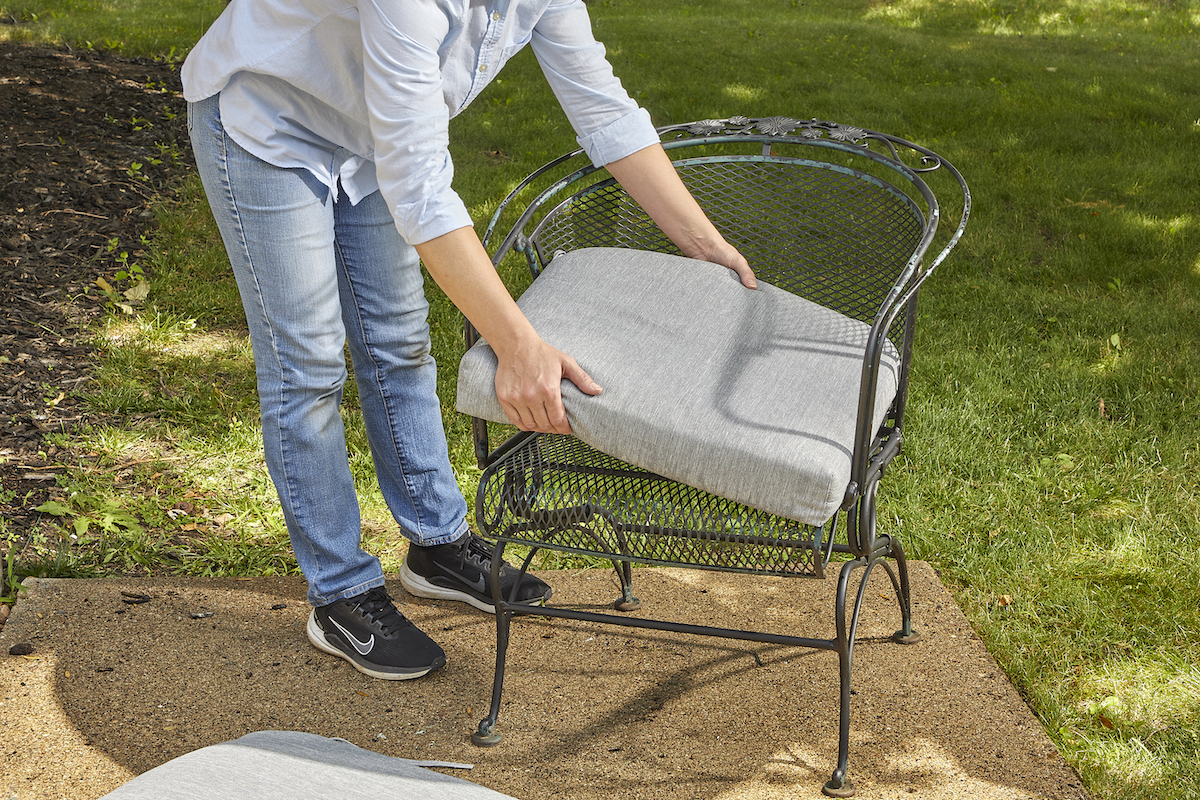
As with many furnishings in and around your home, proper cleaning and maintenance will keep your outdoor cushions looking good for years. Although most outdoor furniture cushions are constructed using fabrics that resist moisture, UV rays, and stains, they still need regular TLC and attention. Here’s how to keep your patio cushions looking their best.
- Cover your outdoor furniture. Use outdoor furniture covers during the winter months, or whenever you will not be using the furniture for an extended period of time. This can help prevent stains as well as fading or other effects of exposure.
- Clean up spills and stains promptly. The longer a stain sits, the harder it will be to remove. Treat your outdoor living space the same way you treat the inside of your home and clean as you go.
- Treat your cushions with a fabric protectant. Many outdoor fabrics are designed for periodic re-treating with water and stain repellents. Check the manufacturer’s instructions and use a spray-on treatment such as 303 Fabric Guard.
- Get them out of the rain. If you are expecting a heavy rain, store your cushions in a protected location so that they don’t get soaked. If they do get wet, open the zipper and stand the cushions on end so the water can drain and the cushions can dry thoroughly. Rain also can rust the furniture’s metal frame.
- Clean seam to seam. When cleaning or removing stains from outdoor cushions, clean the surface of the fabric in the direction of the weave, from seam to seam. Avoid rubbing the fabric in a circular motion.
Final Thoughts
Chic, stylish, durable outdoor furniture often comes with a hefty price tag. Save yourself big bucks by establishing a regular cleaning and maintenance routine that will help you get lots of use out of your patio cushions. Once the cushions are spic and span, start getting the the wicker, wood, or metal frames of your patio furniture clean. Your outdoor space will be ready for lounging and visitors before you know it!
FAQs
The process for how to wash patio cushions that are permanently affixed to the frames can be a little bit more challenging than that of cleaning removable outdoor cushions. Here’s what to do:
1. Prepare a solution of ¼ cup mild soap in 1 gallon of lukewarm water.
2. Using a soft bristle brush, apply the solution seam-to-seam fashion in the direction of the fabric weave.
3. Rinse thoroughly with warm water to remove all soap residue and allow fabric to dry.
Over time, stains build up and colors fade from UV exposure, despite your best efforts to clean and maintain patio cushions. Some outdoor cushion covers can be dyed to bring color back, but it depends upon the material used in the initial construction. Check the manufacturer’s instructions before attempting to dye a fabric.
Most outdoor cushions are made with synthetic fabrics and will require high heat for a dyeing solution. You also will need a large pot to maintain a near-boiling temperature and a dye designed for use with synthetics, such as Rit DyeMore Advanced Liquid Dye for polyester, acrylic, acetate, nylon, and more.
There are several no-sew ways to reupholster outdoor patio cushions: You can use a glue gun, staples, or safety pins to make new covers for your old cushions. Be sure to purchase a fabric designed specifically for outdoor use and get enough to tuck under the cushion for safe use of pointy staples or pins.
Most outdoor patio cushions are constructed of special synthetic fabrics that are pretreated during manufacturing to resist fading and the effects of constant UV exposure. To keep your outdoor cushions fade-free for longer, you might want to consider making slipcovers or using specially fitted outdoor furniture covers.
You also may try situating your outdoor furniture in a shady spot, or removing the patio cushions and storing them in the garage or shed, at least during off months. Some fabrics can be treated (or re-treated) with a UV-resistant spray to minimize fading.

